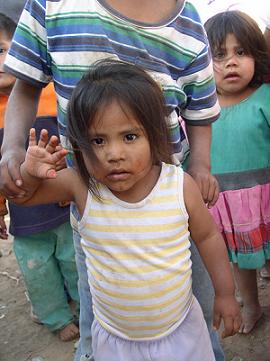
Love in a Shoebox
Did you ever wonder what love looks like? We usually think
of love as a verb; as an emotion. But if love was a noun
what would it look like? Could you fit it in a shoebox?
You could, if you were involved in our annual "Love in a
Shoebox."

"We've been waiting for you."
Each year, in November, we send our love in the
form of practical items placed in a shoebox for a
Triqui boy or a girl who would, otherwise, have
little or nothing at the holidays.
The "Love in a Shoebox" program was brought to
First Baptist Church Galt by a single mom named
Tony, who had taken her kids there to live as a
missionary with her children.
She met Rance and Brandy Cook who had started a
ministry there. They had been doing "Love in a
Shoebox" with a number of churches in California.
First Baptist Church Galt sent six delegates,
including our Pastor and his oldest son to
personally deliver the shoeboxes in 1997.
Since then we have relied on a SEMI-TRUCK to
deliver the shoeboxes each year!
____________
The Triquis live in Mexico's San Quintin Valley,
130 miles south of Ensenada.

It is an area of significant seasonal migration, attracting up
to 30,000 mostly Oaxacan Indian farm workers (including Triquis)
to work in the tomato and strawberry fields that dominate the
Valley. The Valley has only recently been developed and
agriculture is the main economic activity there.
There are two main types of Indian farm workers: those who live
in camps on private land owned by their employers (ranchers),
and others who settle permanently in settlements, or colonias.

"Do you have a shoebox for a little girl?"
The population living in camps is mostly seasonal, with the
majority moving on to other sites of migration in a yearly
circuit. Settlers tend to stay in San Quintin year-round.
___________

"I don't know if they have enough
shoeboxes for all of us."
A study of migration and settlement in San Quintin reveals some
of the needs and demands of Indian migrants as they settle
outside of their traditional territorial communities, how the
state is trying to develop its new relationship with indigenous
peoples, and whether Indian settlers are finding new ways to be
Indian and modeling new ways to be Mexican.

"Yes please, I'd like a shoebox."
____________
Although state presence in this developing region
is growing, it remains far behind the needs of the
population settling there. There are no paved roads
in the Valley except for the peninsular highway
passing through, limited public health facilities,
no sewage in any communities, poor coverage of water
and electricity, and the absence of many public
services and institutions (such as a full capacity
hospital, public courts, etc.) which can only be
found in Ensenada over 100 miles away.

